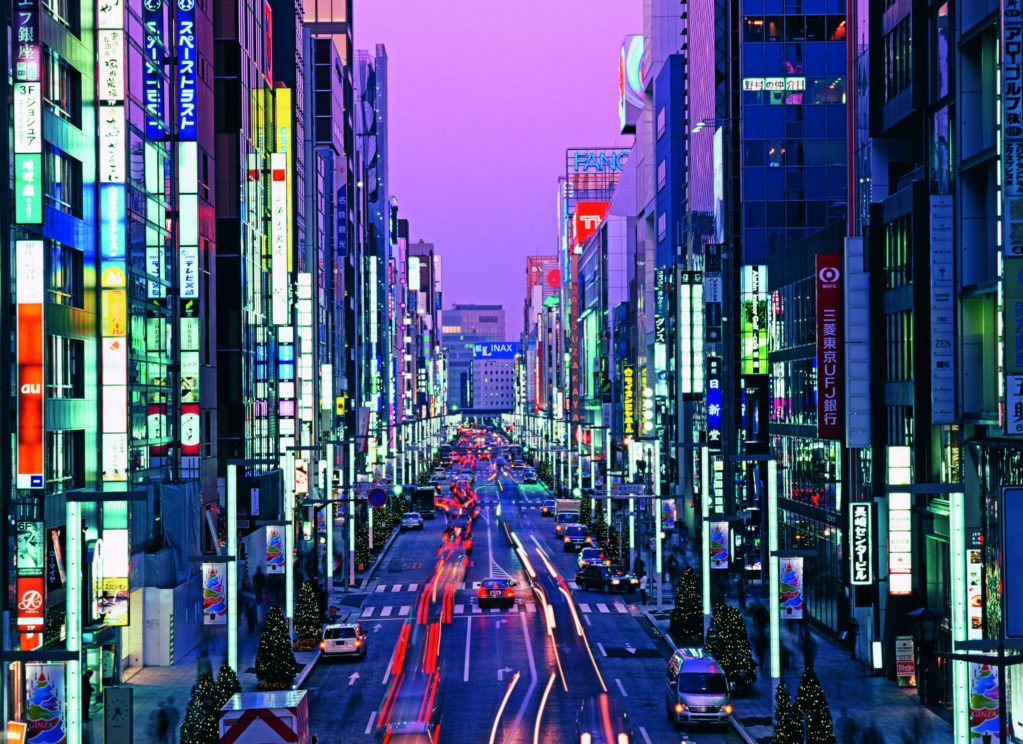In true Japanese hard working fashion, the country has rebuilt rapidly since the earthquake and tsunami of March 2011. The resilience of the people is told in two words: gambaru, to always do one’s best, and gaman, to suffer in silence.
Plan your trip to the Japanese archipelago of 6,852 islands in springtime, during the Sakura cherry blossom festival. It’s part of the Hanami tradition, a celebration of the flowers, that started in the 8th century. The idea is to spend a day picnicking beneath petal showers.

Golden Pavillion, Kyoto
Nara, nearly 40 kilometers south of Kyoto, has 30,000 cherry trees. The former capital is home to eight UNESCO World Heritage sites, vying for your attention: from the 16-meter bronze Buddha in Todai-ji temple to the five-story pagoda at Kofukuji Buddhist Temple. Don’t leave until you’ve visited Kasuga-taisha. The vermillion, wooden, Shinto shrine is located in Nara park, where more than 1,200 deer—the sacred messengers of the shrine’s Shinto gods—roam. Three thousand stone and bronze lanterns are illuminated during the Man-toro lantern festival, which is celebrated in early February.
Kyoto should be at the top of your list if you’re looking for a cultural experience. The city is synonymous with Kinkaku-ji; the zen Buddhist temple also known as the Golden Pavilion. The two top stories are covered in gold leaf. The pavilion ‘floats’ on a pond with 10 small islands. Be sure to take a walk around the splendid garden.
Loading...
A short stroll away, at the Temple of the Dragon at Peace, is the most-celebrated rock garden in Japan. This life-size version of the zen gardens we have in our homes, contains 15 rocks, surrounded by white gravel that is raked daily by monks. While there are many theories about the meaning of the garden, in essence, its intention is to evoke peace.
At sundown, wander the quieter alleyways of the Gion district; you might see a Geisha. Have dinner at one of the many restaurants along the banks of the Kamogawa River, or unwind at a teahouse.
Nearby Osaka is great for a half-day trip, especially if you’re a follower of popular culture. Visit the Dotombori entertainment district, or the southern districts, for a taste of Japan’s nightlife. If it’s electronic goods you’re after Den-Den Town is the place to go. In the Kita area, take a glass tunnel escalator to the top of Umeda Sky Building, with its twin towers. But Osaka’s most popular attraction remains the 16th century Osaka-jo castle with its memorabilia museum.
Hiroshima is a real-life history lesson; there’s no need for a textbook. The city, and all its monuments, are a grave reminder of the atomic bomb dropped by the Americans on August 6, 1945.
If you’re visiting Japan for a week, or longer, buy a discounted Japan rail pass for the Shinkansen bullet train and travel as far as you can. A day trip to Mount Fuji, en route to Tokyo, is well worth it since it’s only 100km south west. The active volcano, which stands at 3,776 meters, hasn’t erupted since 1708. At the foot of the mountain lie five lakes and Fuji-Hakone-Izu National Park.
Once you arrive, you’ll agree that Tokyo is everything you’ve heard about it, and so much more. The multiple subway and train lines that intersect and circle the capital are a worthwhile way to get around. Visit Shinjuku station: the busiest transport hub, according to the Guinness World Records.
Nearby, in Harajuku, you’ll find Takeshita Street. This is where the fashion-conscious youth spend their time, wandering between boutique stores, photo booths and fast food outlets. You’re almost guaranteed to see teenagers engaging in cosplay (costume play). They dress as anime characters, something out of a Halloween movie or in modern Victorian dress.
If you’re a shopaholic, Ginza Street will keep you busy for hours on end or, at least, until your credit card is cut. The Gingko tree-lined street is home to designer and department stores. Rest at a corner cafe or find respite in one of the many art galleries and museums along the stretch.
For sushi, like you’ve never tasted, head to Tsukiji fish market—the world’s largest wholesaler. Be prepared to stand in queues outside the best restaurants, many of which have been featured on Japanese reality TV. It was here that I tried sea urchin for the first time; the delicacy is expensive due to its delicate texture.
As dusk draws near, head up the Tokyo Metropolitan Government Building. Entrance is free and the panoramic cityscape views, from 200 meters up, are priceless.
While in Japan, I read Haruki Murakami—now my favorite Japanese postmodern author—in the hopes of understanding Japanese way of life. There are some things Murakami won’t tell you, like how to make a peace sign with your index and middle finger, when taking photographs, to gain respect from the Japanese.
The best place to start: www. japantravelinfo.com
Loading...
